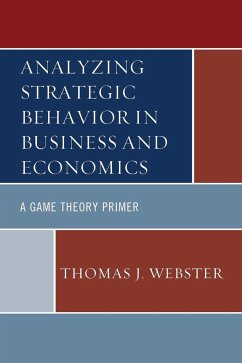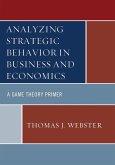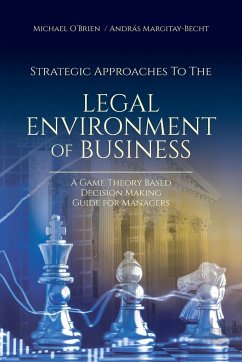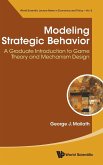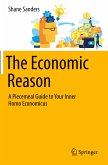- Gebundenes Buch
- Merkliste
- Auf die Merkliste
- Bewerten Bewerten
- Teilen
- Produkt teilen
- Produkterinnerung
- Produkterinnerung
This innovative textbook is a concise and axiomatic introduction to the principles of game theory-the formal study of move and countermove. Undergraduate business and economics students with a background in the principles of microeconomics and college mathematics will find the material presented in this textbook focused, comprehensive, and accessible.
Andere Kunden interessierten sich auch für
![Analyzing Strategic Behavior in Business and Economics Analyzing Strategic Behavior in Business and Economics]() Thomas J. WebsterAnalyzing Strategic Behavior in Business and Economics65,99 €
Thomas J. WebsterAnalyzing Strategic Behavior in Business and Economics65,99 €![Strategic Approaches to the Legal Environment of Business Strategic Approaches to the Legal Environment of Business]() Michael O'BrienStrategic Approaches to the Legal Environment of Business41,99 €
Michael O'BrienStrategic Approaches to the Legal Environment of Business41,99 €![The One Minute Negotiator The One Minute Negotiator]() Don HutsonThe One Minute Negotiator28,99 €
Don HutsonThe One Minute Negotiator28,99 €![MODELING STRATEGIC BEHAVIOR MODELING STRATEGIC BEHAVIOR]() George J MailathMODELING STRATEGIC BEHAVIOR122,99 €
George J MailathMODELING STRATEGIC BEHAVIOR122,99 €![MODELING STRATEGIC BEHAVIOR MODELING STRATEGIC BEHAVIOR]() George J MailathMODELING STRATEGIC BEHAVIOR62,99 €
George J MailathMODELING STRATEGIC BEHAVIOR62,99 €![The Economic Reason The Economic Reason]() Shane SandersThe Economic Reason41,99 €
Shane SandersThe Economic Reason41,99 €![Scholarly Papers From A Brooklyn College Columbia MBA Analyzing Selected Political & Business Issues Scholarly Papers From A Brooklyn College Columbia MBA Analyzing Selected Political & Business Issues]() Christopher A PuelloScholarly Papers From A Brooklyn College Columbia MBA Analyzing Selected Political & Business Issues24,99 €
Christopher A PuelloScholarly Papers From A Brooklyn College Columbia MBA Analyzing Selected Political & Business Issues24,99 €-
-
-
This innovative textbook is a concise and axiomatic introduction to the principles of game theory-the formal study of move and countermove. Undergraduate business and economics students with a background in the principles of microeconomics and college mathematics will find the material presented in this textbook focused, comprehensive, and accessible.
Hinweis: Dieser Artikel kann nur an eine deutsche Lieferadresse ausgeliefert werden.
Hinweis: Dieser Artikel kann nur an eine deutsche Lieferadresse ausgeliefert werden.
Produktdetails
- Produktdetails
- Verlag: Lexington Books
- Seitenzahl: 286
- Erscheinungstermin: 7. Februar 2014
- Englisch
- Abmessung: 260mm x 183mm x 20mm
- Gewicht: 738g
- ISBN-13: 9780739186046
- ISBN-10: 0739186043
- Artikelnr.: 39711796
- Herstellerkennzeichnung
- Libri GmbH
- Europaallee 1
- 36244 Bad Hersfeld
- gpsr@libri.de
- Verlag: Lexington Books
- Seitenzahl: 286
- Erscheinungstermin: 7. Februar 2014
- Englisch
- Abmessung: 260mm x 183mm x 20mm
- Gewicht: 738g
- ISBN-13: 9780739186046
- ISBN-10: 0739186043
- Artikelnr.: 39711796
- Herstellerkennzeichnung
- Libri GmbH
- Europaallee 1
- 36244 Bad Hersfeld
- gpsr@libri.de
By Thomas J. Webster
PREFACE 1 INTRODUCTION TO GAME THEORY Introduction Strategic behavior Short
history of game theory Lexicon of game theory Rational versus actual
behavior Practice Exercises PART I: STATIC GAMES WITH COMPLETE INFORMATION
2 COALITION GAMES Introduction Prisoner's dilemma The extensive form The
normal form Nash equilibrium Shortcut for finding-pure strategy Nash
equilibria Determinants of business collusion Number of firms with similar
interests Firm size relative to the industry Visibility Practice Exercises
3 STRATEGIC MOVES AND DETERRING DEFECTION Introduction Strategic moves
Deterring defection Contracts Reputation Cutting off communications
Preventing retreat Brinksmanship Incrementalism Teamwork Agents Practice
exercises 4 COMPETITION GAMES Introduction Strictly-dominant strategies
Weakly-dominant strategies Iterated elimination of dominated strategies
Three-player games Non-dominant strategies Maximin (secure) strategy
Practice exercises 5 COORDINATION GAMES Introduction Battle-of-the-sexes
game Focal-point equilibrium Developing a theory of focal-point equilibria
Framing Practice Exercises 6 INFINITELY-REPEATED GAMES Introduction
Coalitions Repeated static games Trigger strategies Evaluating payoffs in
infinitely-repeated games Practice Exercises 7 FINITELY-REPEATED GAMES
Introduction Finitely-repeated games with a certain end End-of-game problem
Finitely-repeated games with an uncertain end A word of caution Concluding
remarks Practice Exercises 8 EVOLUTION GAMES Introduction Evolutionary game
theory Reproductive success Evolutionary equilibrium Networks Positive
feedback effects Network game Implications Practice Exercises 9 TIT-FOR-TAT
Introduction Tit-for-tat End-of-game problem Practice Exercises 10 MIXING
PURE STRATEGIES Introduction Zero-sum games Matching pennies Minimax
theorem Mixed strategies Optimal mixing rules Calculating optimal mixing
rules When to use optimal mixing rules How to use optimal mixing rules
Bluffing Practice Exercises 11. CONTINUOUS STRATEGIES Introduction
Continuous strategies Best-response (reaction) functions Tragedy of the
commons Shifting best-response functions Practice Exercises 12. STATIC
OLIGOPOLY GAMES Introduction Cournot model Advertising in a Cournot setting
Bertrand model Bertrand paradox Practice Exercises 13. STRATEGIC TRADE
POLICY Introduction Discrete pure strategies Continuous pure strategies
National welfare Intraindustry trade Imperfect competition Intraindustry
coalitions Export subsidies Reciprocity Practice Exercises 14. PRODUCT
DIFFERENTIATION Introduction Horizontal differentiation Vertical
differentiation Location Product differences Practice exercises 15.
STRATEGIC COMPLEMENTS Introduction Double marginalization Practice
exercises PART II: DYNAMIC GAMES WITH COMPLETE AND PERFECT INFORMATION 16.
GAME TREES Introduction Game trees Subgame perfection Backward induction
Credible threats First-mover advantage Entry deterrence Practice Exercises
17. A DYNAMIC OLIGOPOLY GAME Introduction Stackelberg model Practice
Exercises 18. BARGAINING Introduction The bargaining problem Ultimatum
bargaining Ultimatum paradox Nash bargaining Rubenstein bargaining
Last-mover's advantage Symmetric impatience Asymmetric impatience Practice
Exercises PART III: GAMES WITH INCOMPLETE INFORMATION 19. DECISION MAKING
AND UNCERTAINTY Introduction Risk and uncertainty Static games with
uncertain payoffs Static games in extensive form Dynamic games with
uncertain payoffs Attitudes towards risk Risk aversion Understanding
risk-averse behavior Practice Exercises 20. ADVERSE SELECTION Introduction
The market for lemons Practice Exercises 21. INCENTIVE CONTRACTS
Introduction Principal-agent problem Incentive contracts Principal-agent
problem with moral hazard Practice Exercises PART IV: GAMES WITH IMPERFECT
INFORMATION 22. INFORMATION SETS Introduction Information sets Bayesian
updating Practice Exercises 23. AUCTIONS Introduction Types of auctions
Information structures Complete-information auctions Sealed-bid,
first-price auction Sealed-bid, second-price auction English auction Dutch
auction Expected revenues from complete-information auctions
Incomplete-information auctions with independent private values Sealed-bid,
first-price auction Sealed-bid, second-price auction English auction Dutch
auction Expected revenues from incomplete-information auctions with
independent private values Incomplete-information auctions with correlated
value estimates Common-value auctions and the winner's curse
Incomplete-information auctions and risk aversion Practice exercises 24.
SIGNALING Introduction Spence education game Pooling strategy Separating
strategy Corporate investment game Multiple subgame-perfect Bayesian
equilibria Practice Exercises 25. SCREENING Introduction Self-selection
Spence education game in reverse Practice Exercises APPENDICES REFERENCES
AND SUGGESTIONS FOR FURTHER READING INDEX
history of game theory Lexicon of game theory Rational versus actual
behavior Practice Exercises PART I: STATIC GAMES WITH COMPLETE INFORMATION
2 COALITION GAMES Introduction Prisoner's dilemma The extensive form The
normal form Nash equilibrium Shortcut for finding-pure strategy Nash
equilibria Determinants of business collusion Number of firms with similar
interests Firm size relative to the industry Visibility Practice Exercises
3 STRATEGIC MOVES AND DETERRING DEFECTION Introduction Strategic moves
Deterring defection Contracts Reputation Cutting off communications
Preventing retreat Brinksmanship Incrementalism Teamwork Agents Practice
exercises 4 COMPETITION GAMES Introduction Strictly-dominant strategies
Weakly-dominant strategies Iterated elimination of dominated strategies
Three-player games Non-dominant strategies Maximin (secure) strategy
Practice exercises 5 COORDINATION GAMES Introduction Battle-of-the-sexes
game Focal-point equilibrium Developing a theory of focal-point equilibria
Framing Practice Exercises 6 INFINITELY-REPEATED GAMES Introduction
Coalitions Repeated static games Trigger strategies Evaluating payoffs in
infinitely-repeated games Practice Exercises 7 FINITELY-REPEATED GAMES
Introduction Finitely-repeated games with a certain end End-of-game problem
Finitely-repeated games with an uncertain end A word of caution Concluding
remarks Practice Exercises 8 EVOLUTION GAMES Introduction Evolutionary game
theory Reproductive success Evolutionary equilibrium Networks Positive
feedback effects Network game Implications Practice Exercises 9 TIT-FOR-TAT
Introduction Tit-for-tat End-of-game problem Practice Exercises 10 MIXING
PURE STRATEGIES Introduction Zero-sum games Matching pennies Minimax
theorem Mixed strategies Optimal mixing rules Calculating optimal mixing
rules When to use optimal mixing rules How to use optimal mixing rules
Bluffing Practice Exercises 11. CONTINUOUS STRATEGIES Introduction
Continuous strategies Best-response (reaction) functions Tragedy of the
commons Shifting best-response functions Practice Exercises 12. STATIC
OLIGOPOLY GAMES Introduction Cournot model Advertising in a Cournot setting
Bertrand model Bertrand paradox Practice Exercises 13. STRATEGIC TRADE
POLICY Introduction Discrete pure strategies Continuous pure strategies
National welfare Intraindustry trade Imperfect competition Intraindustry
coalitions Export subsidies Reciprocity Practice Exercises 14. PRODUCT
DIFFERENTIATION Introduction Horizontal differentiation Vertical
differentiation Location Product differences Practice exercises 15.
STRATEGIC COMPLEMENTS Introduction Double marginalization Practice
exercises PART II: DYNAMIC GAMES WITH COMPLETE AND PERFECT INFORMATION 16.
GAME TREES Introduction Game trees Subgame perfection Backward induction
Credible threats First-mover advantage Entry deterrence Practice Exercises
17. A DYNAMIC OLIGOPOLY GAME Introduction Stackelberg model Practice
Exercises 18. BARGAINING Introduction The bargaining problem Ultimatum
bargaining Ultimatum paradox Nash bargaining Rubenstein bargaining
Last-mover's advantage Symmetric impatience Asymmetric impatience Practice
Exercises PART III: GAMES WITH INCOMPLETE INFORMATION 19. DECISION MAKING
AND UNCERTAINTY Introduction Risk and uncertainty Static games with
uncertain payoffs Static games in extensive form Dynamic games with
uncertain payoffs Attitudes towards risk Risk aversion Understanding
risk-averse behavior Practice Exercises 20. ADVERSE SELECTION Introduction
The market for lemons Practice Exercises 21. INCENTIVE CONTRACTS
Introduction Principal-agent problem Incentive contracts Principal-agent
problem with moral hazard Practice Exercises PART IV: GAMES WITH IMPERFECT
INFORMATION 22. INFORMATION SETS Introduction Information sets Bayesian
updating Practice Exercises 23. AUCTIONS Introduction Types of auctions
Information structures Complete-information auctions Sealed-bid,
first-price auction Sealed-bid, second-price auction English auction Dutch
auction Expected revenues from complete-information auctions
Incomplete-information auctions with independent private values Sealed-bid,
first-price auction Sealed-bid, second-price auction English auction Dutch
auction Expected revenues from incomplete-information auctions with
independent private values Incomplete-information auctions with correlated
value estimates Common-value auctions and the winner's curse
Incomplete-information auctions and risk aversion Practice exercises 24.
SIGNALING Introduction Spence education game Pooling strategy Separating
strategy Corporate investment game Multiple subgame-perfect Bayesian
equilibria Practice Exercises 25. SCREENING Introduction Self-selection
Spence education game in reverse Practice Exercises APPENDICES REFERENCES
AND SUGGESTIONS FOR FURTHER READING INDEX
PREFACE 1 INTRODUCTION TO GAME THEORY Introduction Strategic behavior Short
history of game theory Lexicon of game theory Rational versus actual
behavior Practice Exercises PART I: STATIC GAMES WITH COMPLETE INFORMATION
2 COALITION GAMES Introduction Prisoner's dilemma The extensive form The
normal form Nash equilibrium Shortcut for finding-pure strategy Nash
equilibria Determinants of business collusion Number of firms with similar
interests Firm size relative to the industry Visibility Practice Exercises
3 STRATEGIC MOVES AND DETERRING DEFECTION Introduction Strategic moves
Deterring defection Contracts Reputation Cutting off communications
Preventing retreat Brinksmanship Incrementalism Teamwork Agents Practice
exercises 4 COMPETITION GAMES Introduction Strictly-dominant strategies
Weakly-dominant strategies Iterated elimination of dominated strategies
Three-player games Non-dominant strategies Maximin (secure) strategy
Practice exercises 5 COORDINATION GAMES Introduction Battle-of-the-sexes
game Focal-point equilibrium Developing a theory of focal-point equilibria
Framing Practice Exercises 6 INFINITELY-REPEATED GAMES Introduction
Coalitions Repeated static games Trigger strategies Evaluating payoffs in
infinitely-repeated games Practice Exercises 7 FINITELY-REPEATED GAMES
Introduction Finitely-repeated games with a certain end End-of-game problem
Finitely-repeated games with an uncertain end A word of caution Concluding
remarks Practice Exercises 8 EVOLUTION GAMES Introduction Evolutionary game
theory Reproductive success Evolutionary equilibrium Networks Positive
feedback effects Network game Implications Practice Exercises 9 TIT-FOR-TAT
Introduction Tit-for-tat End-of-game problem Practice Exercises 10 MIXING
PURE STRATEGIES Introduction Zero-sum games Matching pennies Minimax
theorem Mixed strategies Optimal mixing rules Calculating optimal mixing
rules When to use optimal mixing rules How to use optimal mixing rules
Bluffing Practice Exercises 11. CONTINUOUS STRATEGIES Introduction
Continuous strategies Best-response (reaction) functions Tragedy of the
commons Shifting best-response functions Practice Exercises 12. STATIC
OLIGOPOLY GAMES Introduction Cournot model Advertising in a Cournot setting
Bertrand model Bertrand paradox Practice Exercises 13. STRATEGIC TRADE
POLICY Introduction Discrete pure strategies Continuous pure strategies
National welfare Intraindustry trade Imperfect competition Intraindustry
coalitions Export subsidies Reciprocity Practice Exercises 14. PRODUCT
DIFFERENTIATION Introduction Horizontal differentiation Vertical
differentiation Location Product differences Practice exercises 15.
STRATEGIC COMPLEMENTS Introduction Double marginalization Practice
exercises PART II: DYNAMIC GAMES WITH COMPLETE AND PERFECT INFORMATION 16.
GAME TREES Introduction Game trees Subgame perfection Backward induction
Credible threats First-mover advantage Entry deterrence Practice Exercises
17. A DYNAMIC OLIGOPOLY GAME Introduction Stackelberg model Practice
Exercises 18. BARGAINING Introduction The bargaining problem Ultimatum
bargaining Ultimatum paradox Nash bargaining Rubenstein bargaining
Last-mover's advantage Symmetric impatience Asymmetric impatience Practice
Exercises PART III: GAMES WITH INCOMPLETE INFORMATION 19. DECISION MAKING
AND UNCERTAINTY Introduction Risk and uncertainty Static games with
uncertain payoffs Static games in extensive form Dynamic games with
uncertain payoffs Attitudes towards risk Risk aversion Understanding
risk-averse behavior Practice Exercises 20. ADVERSE SELECTION Introduction
The market for lemons Practice Exercises 21. INCENTIVE CONTRACTS
Introduction Principal-agent problem Incentive contracts Principal-agent
problem with moral hazard Practice Exercises PART IV: GAMES WITH IMPERFECT
INFORMATION 22. INFORMATION SETS Introduction Information sets Bayesian
updating Practice Exercises 23. AUCTIONS Introduction Types of auctions
Information structures Complete-information auctions Sealed-bid,
first-price auction Sealed-bid, second-price auction English auction Dutch
auction Expected revenues from complete-information auctions
Incomplete-information auctions with independent private values Sealed-bid,
first-price auction Sealed-bid, second-price auction English auction Dutch
auction Expected revenues from incomplete-information auctions with
independent private values Incomplete-information auctions with correlated
value estimates Common-value auctions and the winner's curse
Incomplete-information auctions and risk aversion Practice exercises 24.
SIGNALING Introduction Spence education game Pooling strategy Separating
strategy Corporate investment game Multiple subgame-perfect Bayesian
equilibria Practice Exercises 25. SCREENING Introduction Self-selection
Spence education game in reverse Practice Exercises APPENDICES REFERENCES
AND SUGGESTIONS FOR FURTHER READING INDEX
history of game theory Lexicon of game theory Rational versus actual
behavior Practice Exercises PART I: STATIC GAMES WITH COMPLETE INFORMATION
2 COALITION GAMES Introduction Prisoner's dilemma The extensive form The
normal form Nash equilibrium Shortcut for finding-pure strategy Nash
equilibria Determinants of business collusion Number of firms with similar
interests Firm size relative to the industry Visibility Practice Exercises
3 STRATEGIC MOVES AND DETERRING DEFECTION Introduction Strategic moves
Deterring defection Contracts Reputation Cutting off communications
Preventing retreat Brinksmanship Incrementalism Teamwork Agents Practice
exercises 4 COMPETITION GAMES Introduction Strictly-dominant strategies
Weakly-dominant strategies Iterated elimination of dominated strategies
Three-player games Non-dominant strategies Maximin (secure) strategy
Practice exercises 5 COORDINATION GAMES Introduction Battle-of-the-sexes
game Focal-point equilibrium Developing a theory of focal-point equilibria
Framing Practice Exercises 6 INFINITELY-REPEATED GAMES Introduction
Coalitions Repeated static games Trigger strategies Evaluating payoffs in
infinitely-repeated games Practice Exercises 7 FINITELY-REPEATED GAMES
Introduction Finitely-repeated games with a certain end End-of-game problem
Finitely-repeated games with an uncertain end A word of caution Concluding
remarks Practice Exercises 8 EVOLUTION GAMES Introduction Evolutionary game
theory Reproductive success Evolutionary equilibrium Networks Positive
feedback effects Network game Implications Practice Exercises 9 TIT-FOR-TAT
Introduction Tit-for-tat End-of-game problem Practice Exercises 10 MIXING
PURE STRATEGIES Introduction Zero-sum games Matching pennies Minimax
theorem Mixed strategies Optimal mixing rules Calculating optimal mixing
rules When to use optimal mixing rules How to use optimal mixing rules
Bluffing Practice Exercises 11. CONTINUOUS STRATEGIES Introduction
Continuous strategies Best-response (reaction) functions Tragedy of the
commons Shifting best-response functions Practice Exercises 12. STATIC
OLIGOPOLY GAMES Introduction Cournot model Advertising in a Cournot setting
Bertrand model Bertrand paradox Practice Exercises 13. STRATEGIC TRADE
POLICY Introduction Discrete pure strategies Continuous pure strategies
National welfare Intraindustry trade Imperfect competition Intraindustry
coalitions Export subsidies Reciprocity Practice Exercises 14. PRODUCT
DIFFERENTIATION Introduction Horizontal differentiation Vertical
differentiation Location Product differences Practice exercises 15.
STRATEGIC COMPLEMENTS Introduction Double marginalization Practice
exercises PART II: DYNAMIC GAMES WITH COMPLETE AND PERFECT INFORMATION 16.
GAME TREES Introduction Game trees Subgame perfection Backward induction
Credible threats First-mover advantage Entry deterrence Practice Exercises
17. A DYNAMIC OLIGOPOLY GAME Introduction Stackelberg model Practice
Exercises 18. BARGAINING Introduction The bargaining problem Ultimatum
bargaining Ultimatum paradox Nash bargaining Rubenstein bargaining
Last-mover's advantage Symmetric impatience Asymmetric impatience Practice
Exercises PART III: GAMES WITH INCOMPLETE INFORMATION 19. DECISION MAKING
AND UNCERTAINTY Introduction Risk and uncertainty Static games with
uncertain payoffs Static games in extensive form Dynamic games with
uncertain payoffs Attitudes towards risk Risk aversion Understanding
risk-averse behavior Practice Exercises 20. ADVERSE SELECTION Introduction
The market for lemons Practice Exercises 21. INCENTIVE CONTRACTS
Introduction Principal-agent problem Incentive contracts Principal-agent
problem with moral hazard Practice Exercises PART IV: GAMES WITH IMPERFECT
INFORMATION 22. INFORMATION SETS Introduction Information sets Bayesian
updating Practice Exercises 23. AUCTIONS Introduction Types of auctions
Information structures Complete-information auctions Sealed-bid,
first-price auction Sealed-bid, second-price auction English auction Dutch
auction Expected revenues from complete-information auctions
Incomplete-information auctions with independent private values Sealed-bid,
first-price auction Sealed-bid, second-price auction English auction Dutch
auction Expected revenues from incomplete-information auctions with
independent private values Incomplete-information auctions with correlated
value estimates Common-value auctions and the winner's curse
Incomplete-information auctions and risk aversion Practice exercises 24.
SIGNALING Introduction Spence education game Pooling strategy Separating
strategy Corporate investment game Multiple subgame-perfect Bayesian
equilibria Practice Exercises 25. SCREENING Introduction Self-selection
Spence education game in reverse Practice Exercises APPENDICES REFERENCES
AND SUGGESTIONS FOR FURTHER READING INDEX

